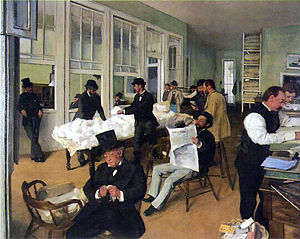- A Cotton Office in New Orleans
-
A Cotton Office in New Orleans 
Artist Edgar Degas Year 1873 Type oil on canvas Dimensions 73 cm × 92 cm (29 in × 36 in) Location Musée des beaux-arts de Pau A Cotton Office in New Orleans is an 1873 oil painting by Edgar Degas. In it, Degas depicts the moment when his uncle Michel Musson's cotton brokerage business went bankrupt in an economic crash, according to Michael McMahon of the Pittsburgh Post-Gazette. The firm was swamped by the postwar growth of the much larger Cotton Exchange. In the painting, Musson is seen examining raw cotton for its quality while Degas' brother Rene reads The Daily Picayune. It carried the bankruptcy news. Another brother, Achille, rests against a window wall at left while others, including Musson's partners, go about their business.[1]
A Cotton Office in New Orleans is the first painting by Degas to be purchased by a museum, and the first by an Impressionist.[2] Degas' sale of the piece marks a turning point in his career as he moved from being a struggling unrecognized artist to a recognized and financially stable artist, according to Marilyn Brown in her book Degas and the Business of Art: A Cotton Office in New Orleans.[3]
Degas traveled from Europe to New Orleans in late 1872 with his brother, René, to visit his mother's brother, Michael Musson.[3] After the American Civil War, René had joined his uncle's cotton factor firm in New Orleans.[3] Degas was to return to Europe in January 1873, but when his return trip was delayed, he decided to paint the cotton business surrounding him.[3]
Degas crafted his work with the intent of selling it to a British textile manufacturer. But a drop in stock prices worldwide and declines in the cotton and art markets ended his hopes for that specific sale.[4] Degas then exhibited A Cotton Office in New Orleans in the second Impressionist show in Paris in 1876. Degas finally sold the painting in 1878 to the newly founded Musee des Beaux-Arts in Pau, France.[4]
The painting is sometimes mistakenly referred to as The Cotton Exchange at New Orleans.[5]
References
- ^ Excellent Exhibitions Detail Mark of French Influence, Pittsburgh Post-Gazette, July 3, 1999
- ^ Degas and the Business of Art: A Cotton Office in New Orleans, Marilyn Brown, Pennsylvania State University Press, 1994
- ^ a b c d Degas and the Business of Art: A Cotton Office in New Orleans, Marilyn Brown, Pennsylvania State University Press, 1994.
- ^ a b Degas and the Business of Art: A Cotton Office in New Orleans, Marilyn Brown, Pennsylvania State University Prss, 1994.
- ^ Louisiana History: The Journal of the Louisiana Historical Association, 1995.
Sources
- Brown, Marilyn R.; (1994). Degas and the Business of Art: A Cotton Office in New Orleans. Pennsylvania State University Press. ISBN 0-271-00944-6 Pg. 4.
Edgar Degas Paintings The Bellelli Family (1858–1867) · Young Spartans Exercising (1860) · Interior (1868–1869) · Count Lepic and His Daughters (1870) · A Cotton Office in New Orleans (1873) · The Dance Class (1874) · Place de la Concorde (1875) · L'Absinthe (1876) · Miss La La at the Cirque Fernando (1879) · Portraits, At the Stock Exchange (1879) · After the Bath, Woman Drying her Feet (1886)Pastels Waiting (1880-82)Sculptures Study in the Nude for the Dressed Ballet Dancer (1878-1879) · La Petite Danseuse de Quatorze Ans (1881)Categories:- 1873 paintings
- Edgar Degas paintings
Wikimedia Foundation. 2010.
